This is one of the most visually moving diseases found in almond. Once upon the location of the problem, not only is the disease obvious by looking at the trees, but the air is also filled with a fermented-like smell reminding one a bar when entering for happy hour.
Overall Orchard Information:
The orchard I was called out to visit was described as a complete loss to foamy canker. To me this came as a bit of a surprise as foamy canker typically comes later in the season. By time I have arrived, the grower was in the process of removing the orchard. The entire orchard was exhibiting symptoms of foamy canker (Picture 1), poor growth and dieing trees.

Photo 1: Overview of the almond variety Fritz with foamy canker
The orchard was a Nonpareil-Fritz-Monterrey on Lovell planted on clay/clay loam soil. The trees were in their 4th Leaf trees with average growth. Nut set of the trees was decent, but not great. Speaking with the grower, he mentioned that the orchard has a high water table, found at about 7 feet with subbing up to 4-5 feet. Quality of the water was unknown. The site is also high in boron within its soil, and has a history of verticillium wilt (old tomato and melon ground). Overall, the discussion yielded that there were many issues from the start with the orchard – over 30% of the Fritz variety planted in the first year did not survive and needed to be replanted.
Irrigation of the trees tends to be minimal due to the high water table. The grower does not irrigate often – only 8 inches last year through double line drip. Nitrogen usage is minimum, but tree vigor is high due to being the first generation orchard on old row crop ground.
Observed Symptoms:
Foamy canker was found on both Nonpareil and Fritz varieties (Picture 2), but not Monterrey. All varieties had extensive cracks up and down the trunk (Picture 3). Removal of bark from around trunk cracks indicated necrotic tissues (Picture 4). Removal of scaffolds indicated verticillium wilt infections – all scaffolds on trees surveyed had vascular discoloration. The grower told me about the progression of symptoms before seeing foamy canker. They are as follows: 2nd year, the trees exuded a clear gum, followed by amber gumming in the 3rd leaf. This year, over 80% of the fritz, 20% of the nonpareil have foamy canker. No clear evidence of any insect borer was found in the crotch of the trees.

Picture 2: Close up of the almond variety Fritz with the disease foamy canker.
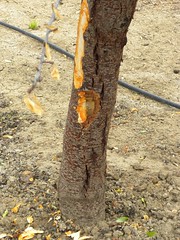
Picture 3: Close up of cankers found on the trunk of almond trees associated with the disease foamy canker.
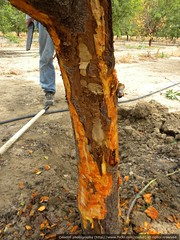
Picture 4: Bark removal from around the cracks of foamy canker affected almond trees yields a large canker that extends from the crotch to near the graft union.
A walk through the orchard after the visit with the grower yielded a “dead spot.” About a 4 acre area of trees with interesting symptomology. The Nonpareils were completely dead, the Fritz all had foamy canker, and the Monterrey all were alive but were struggling. Viewing the excavated trees, the root systems looked equally developed, but the root systems by the Monterrey/Lovell looked slightly larger than the Fritz/Lovell or Nonpareil/Lovell (pictures 4-6). I assuming this is due to how vigorous Monterrey grows.
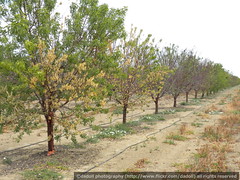
Picture 4: Overview of a row of the almond variety Fritz with foamy canker symptoms.
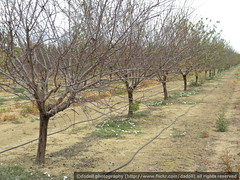
Picture 5: Overview of a row of the almond variety Nonpareil with foamy canker symptoms.
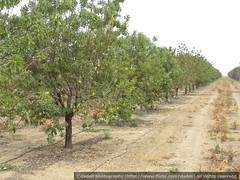
Picture 6: Overview of a row of the almond variety Monterrey with foamy canker symptoms.
Previous research on foamy canker has been limited. It typically affects the Carmel variety within the first four years of orchard life. Symptoms usually appear in the summer after a hot weather spell in which a reddish gum flows from cankers found on the trunk and the crotch of the tree. Symptoms are most pronounced when a white froth forms from the cankers, emitting an alcohol like smell. Cankers are irregularly shaped, and tend not to reactivate the following year. Foamy canker is often associated with previous diseases or problems.
The foam associated with the disease is due to the occurrence of the fermentative bacteria found within the vascular system known as Zymomonas. Koch’s postulates were performed on Zymomonas, but causality was not defined. It is clear that this bacteria causes a buildup of gasses and fluids that erupt when the pressure is great enough to break through the surface of the bark. This is known as alcoholic flux (Picture 7). The formation of the anaerobic situation that happens within the vascular tissue of the tree is unclear, as well as what factors that predispose the tree to disease.
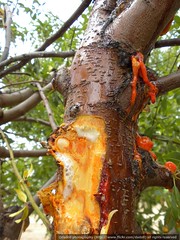
Picture 7: White froth/foam associated with the almond tree disease of Foamy Canker.
The appearance of the cracks on the bark and large canker found upon bark removal suggests that the disease is found throughout the tree. Further bark removal reveals a layer of white, macerated tissue found near the cambial layer (Picture 8). Observations of the scaffold area revealed a weak structure with excessive gumming (Picture 9). Trees can gum excessively when a large area is damaged, so this was not too much of an oddity. Could the excessive gumming, however, within the scaffold triggered the the anaeorbic conditions for the expression of the disease? As far as the bark cracking, I would guess that it is most likely from the previous year’s infection.
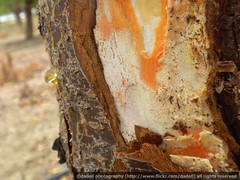
Picture 8: The layer of white macerated tissue found near the cambial layer of an almond tree affected with foamy canker.

Picture 9: Excessive gumming from wind damage found within the crotch of the almond tree.
As one can see, there is much to be learned about foamy canker of almond. Not knowing the epidemiology of the disease, there are no direct recommendations that can be made for the grower. In this case, recommendations to the grower for future plantings were to maintain healthy trees and remove diseased trees when they become apparent.
EDITORS NOTE: For larger pictures please refer to http://www.flickr.com/dadoll


[LaLa] Lauren
June 17, 2009Wow, this is probably a really bad thing to happen to your trees, but it looks so cool! I love the last photo..
MAT kinase
June 19, 2009that’s incredible… do the trees bleed out and die quickly or does it take a long time for all that goo to accumulate?
The Almond Doctor
June 21, 2009MAT Kinase: The bleeding occurs over a 2 week period or so. Surprisingly enough, the amount of “goo” that was visible in the pictures occurred over a 10 day period. A very impressive disease!
nick
July 2, 2013My Girlfiend has just got herself a lovely place in the hills of Alicanti, Spain it has a mixture of both Olive and Almond all tree are in fruit at the moment but one of the Almonds seems to doing not so well.
Probably one of the more mature tree but the leaves are drooping and always look wet, it attracts swarms of insects mainly flies and there is this “gloopy”,trickle of what looks like treacle coming from its bark.
I thought it was just sap as it is amber in colour.
Is this normal or is this infact, canker, if so how contageouse is it and more importantly is there a cure?
Many thanks in advance of any help you could offer
David Doll
July 3, 2013Nick,
It is not contagious and we do not know the cure. It does appear that some type of prolonged stress on the tree triggers the symptoms. I know that is not much more information, but for the most part, what we know is int he above entry.
David
Amanda Thomas
April 2, 2016Once an infected tree is removed, is it okay to plant a new tree in the same or close to the old location?
David Doll
April 8, 2016Amanda,
We do not know enough about this disease to really answer. My guess is that it depends on what may be the actual primary cause of the foamy canker. If it is due to a one time environmental issue, yes. If due to water table, nematodes, or other issues, maybe not. If it is a few trees, I say it is worth it.
David
hadi
August 17, 2022Because this disease does not have an exact and known cause, so nothing can be said. Some studies identify fungi, yeasts, and bacteria as the cause of this disease. However, it is not possible to comment precisely.